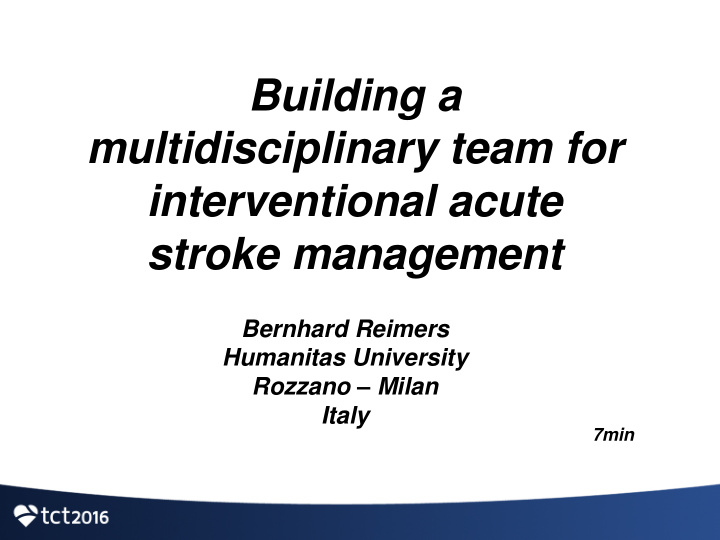



Building a multidisciplinary team for interventional acute stroke management Bernhard Reimers Humanitas University Rozzano – Milan Italy 7min
Disclosure Statement of Financial Interest I, Bernhard Reimers, DO NOT have a financial interest/arrangement or affiliation with one or more organizations that could be perceived as a real or apparent conflict of interest in the context of the subject of this presentation
Stroke is multidisciplinary (Too many cooks ruin the dish or is it an occasion?)
‘Tower of Power’ 0.014” wire (Transend) Micro catheter (Velocity 160cm 2.95-2.6 F) Reperfusion catheter (5 Max ACE 0.68- 64”) Long sheath (Neuron Max 6F 0.88” 105 or 125 cm)
‘Tower of Power’ Step 4: Open the artery Step 3: Get multiphase CT on admission. Decide indications. Apply 24/7 primary PCI standards. Step 2: Train and certify team players Step 1: Get neurologist, neuro-radiologist, cardiologist, & hospital administration in the same boat
Step 1: Get neurologist, neuro-radiologist, cardiologist, & hospital administration in the same boat Most difficult step : The beginning - Now we have new guidelines - We need to convince colleagues & administration that ‘our’ hospital has to deliver endovascular treatment to patients admitted with a stroke with indications for interventional treatment - Overcome jealousy, rivalry, old ‘power’ schemes …... - Overcome specialities and scientific societies!!
Every Hospital, every region, every country, every scientific society are.. .. similar: Neurologists are afraid of cardiologists. There are not enough interventional (Neuro -) radiologist. Administrators are afraid of costs. Ambulances (911) need instructions where to bring the patients.
Every Hospital, every region, every country, every scientific society are.. .. different : - Italy: scientific societies of neurologists and neuro- radiologists exclude cardiologist from teaching programs. - Europe: Only hub-centers with enough neuroradiologists to cover 24/7 are certified. Only few centers provide 24/7 coverage. - Interventional cardiologists arrogantly say there isn’t any problem to open -up an intracranial artery ( it’s not even moving ).
Every Hospital, every region, every country, every scientific society are.. .. different : Czech Republic: leading for stroke treatment performed by cardiologists. Russia: The government just decided that ‘ interventionalists ’ have to provide endovascular stroke treatment. Rest of the world: Some zones very well served, others not! (0-5% of patients admitted with stroke recieve interventional treatment)
Good Example from >10 years ago • One of the most stimulating approaches to stroke treatment was organized by the inventor of carotid artery angioplasty. Klaus Matthias founded the Stroke-Club Dortmund serving approximately 1 Mio of people and performing >150 endovascular stroke interventions per year. In the club: neurologists, (neuro-) radiologists, 911, .. • The concept of Club underlines the willingness of all doctors to collaborate in order to provide the best possible treatment to one oft he most devastating pathologies we have to face.
What can the cardiologist do (step 2): Scientific Societies: work together to produce common protocols and common teaching / certification programs Administration: Imagine it’s you having a stroke at work. You would like to get best possible treatment according to guidelines (1a). It’s a delicate situations which requires some diplomacy, but there is not any time to loose !! (push!)
What can the cardiologist do (step 3): Big center > 4 Neuroradiologists able to perform 24/7 stroke program: - Give a hand with logistics - Priority access to cathlab (Stroke before AMI) - Help to ‘push’ administration - Make sure multiphase CT available Smaller center < 3 Neuroradiologists, unable to perform 24/7 stroke program: - Team - building (not team - leading) cardiologist with neurologist and neuroradiologist - Humble studying anatomy and technique; get certified - Get scrubbed wiht neuroradiologists - Priority access to cathlab (Stroke before AMI)
Endovascular treatment (Step 4) Neuron MAX 088 long sheath, After thrombus aspiraton 5MAX ACE 64 reperfusion catheter, Velocity microcatheter Transend EX 0.014 guidewire
In conclusion: Let’s put heart and brain together: - The neurologists gives the indication - The neuroradiologists has and teaches the skills - The cardiologists helps with the logistics and gives a hand bernhard.reimers@humanitas.it
Smaller Center
Another practical problem – Stroke is multidisciplinary The diagnosis and the treatment of stroke is multidisciplinary. Rigid protocols with fast execution need to be applied: - Stroke is diagnosed by the A&E Doctor - Direct CT + angio and perfusion CT should be performed (the use of contrast in many countries requires the presence of the Radiologist) - The Neurologist gives indications for lysis or endovascular treatment - The interventionalist needs to be available 24/7
Another practical problem – Stroke is multidisciplinary Best scenarium = big center : - Resident radiologist (CT) - Resident Neurologist (Indication) - on call Neuroradiologist (evaluates on line images & comes in for intervention) - 2 cathlabs & 2 on call nursing/technician teams for stroke - stroke unit You Need: 6 Radiologists, 6 Neurologists, 3-4 Radioneurologists, 12-16 on call nurses But: Primary PCI for AMI experience: few big centers are not enough
Stroke is multidisciplinary Alternatively - A&E (clinical diagnosis & CT imaging) (stroke/MI ): - on call/resident Neurologist (indications) - on call neuroradiologist (evaluates on line images) - on call team of Interventionalists* (comes in for intervention) - 1-2 cathlabs & 1 on call nursing/technician teams for stroke/MI - stroke unit or intensive coronary care unit You need: A&E; ≥2 Neurologists; ≥2 Neuroradiologists; 6 Interventionalists: 2 (Neuro)radiologists and 2 Cardiologists Stroke Interventionalists training: - Teamleader: Neuroradiologist trains and certifies cardiologists or interventional radiologists.
Recommend
More recommend